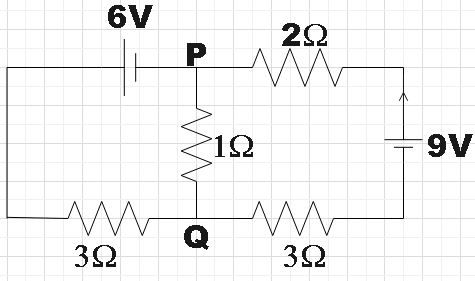
In the circuit shown, the current in the $1\Omega $ resistor is

A. 1.3A, from P to Q
B. 0A
C. 0.13A, from Q to P
D. 0.13A, from P to Q

Answer
524.7k+ views
Hint: As a very first step, you could assume directions for current in every arm in the given circuit. Then you could consider two loops as per your convenience. After that, you could apply kirchoff’s current law each of these loops. Then by doing necessary substitutions find the answer.
Complete answer:
In the question, we are given a circuit and we are supposed to find the current across the $1\Omega $ resistor. Let us assume current direction for all the arms of the circuit.

Now, we could apply kirchhoff's voltage law in either of the loops that are marked in the above figure.
For loop 1, on applying kirchhoff's voltage law we get,
$+9-2i-{{i}_{1}}-3i=0$
$\Rightarrow 9={{i}_{1}}+5i$ ………………………………………… (1)
Now, for loop 2, on applying kirchhoff's voltage law, we get,
$+6-\left( i-{{i}_{1}} \right)3+{{i}_{1}}=0$
$\Rightarrow 3i=6+4{{i}_{{{1}_{{}}}}}$
$\Rightarrow i=\dfrac{6+4{{i}_{1}}}{3}$ ………………………………………. (2)
Now, we could simply substitute (2) in equation (1) and thus get,
${{i}_{1}}+5\left( \dfrac{6+4i}{3} \right)=9$
$\Rightarrow 3{{i}_{1}}+30+20{{i}_{1}}=27$
$\Rightarrow 23{{i}_{1}}=-3$
$\therefore {{i}_{1}}=-0.13A$
Therefore, we found that the current across the $1\Omega $ resistor is 0.13A and the negative sign indicates that the direction of the current is opposite to that we assumed that is from Q to P is the correct direction of current.
Hence, option C is found to be the correct answer.
Note:
While solving this question, we found how significant is the role played by signs. You must take care while assigning signs as per known convention while applying kirchoff’s law. Also, it is not necessary that the assumed direction for current in the first step is always right. Following the rest of the steps by assigning the correct sign will give you the answer correctly.
Complete answer:
In the question, we are given a circuit and we are supposed to find the current across the $1\Omega $ resistor. Let us assume current direction for all the arms of the circuit.

Now, we could apply kirchhoff's voltage law in either of the loops that are marked in the above figure.
For loop 1, on applying kirchhoff's voltage law we get,
$+9-2i-{{i}_{1}}-3i=0$
$\Rightarrow 9={{i}_{1}}+5i$ ………………………………………… (1)
Now, for loop 2, on applying kirchhoff's voltage law, we get,
$+6-\left( i-{{i}_{1}} \right)3+{{i}_{1}}=0$
$\Rightarrow 3i=6+4{{i}_{{{1}_{{}}}}}$
$\Rightarrow i=\dfrac{6+4{{i}_{1}}}{3}$ ………………………………………. (2)
Now, we could simply substitute (2) in equation (1) and thus get,
${{i}_{1}}+5\left( \dfrac{6+4i}{3} \right)=9$
$\Rightarrow 3{{i}_{1}}+30+20{{i}_{1}}=27$
$\Rightarrow 23{{i}_{1}}=-3$
$\therefore {{i}_{1}}=-0.13A$
Therefore, we found that the current across the $1\Omega $ resistor is 0.13A and the negative sign indicates that the direction of the current is opposite to that we assumed that is from Q to P is the correct direction of current.
Hence, option C is found to be the correct answer.
Note:
While solving this question, we found how significant is the role played by signs. You must take care while assigning signs as per known convention while applying kirchoff’s law. Also, it is not necessary that the assumed direction for current in the first step is always right. Following the rest of the steps by assigning the correct sign will give you the answer correctly.
Recently Updated Pages
Why are manures considered better than fertilizers class 11 biology CBSE

Find the coordinates of the midpoint of the line segment class 11 maths CBSE

Distinguish between static friction limiting friction class 11 physics CBSE

The Chairman of the constituent Assembly was A Jawaharlal class 11 social science CBSE

The first National Commission on Labour NCL submitted class 11 social science CBSE

Number of all subshell of n + l 7 is A 4 B 5 C 6 D class 11 chemistry CBSE

Trending doubts
What is meant by exothermic and endothermic reactions class 11 chemistry CBSE

10 examples of friction in our daily life

One Metric ton is equal to kg A 10000 B 1000 C 100 class 11 physics CBSE

1 Quintal is equal to a 110 kg b 10 kg c 100kg d 1000 class 11 physics CBSE

Difference Between Prokaryotic Cells and Eukaryotic Cells

What are Quantum numbers Explain the quantum number class 11 chemistry CBSE




